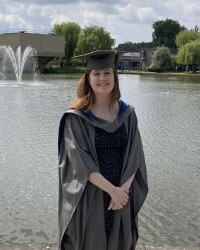Lyndsay Ives
Biography
I'm a PhD student within the Wolfson Atmospheric Chemistry Laboratories (WACL) at the University of York. I also undertook my undergraduate degree at York in Natural Sciences, with my final year Masters project within WACL.
My Masters project focused on determining the chemical controls on ozone deposition velocity to coastal waters using a heterogeneous flow reactor. I chose to do a PhD in atmospheric chemistry because I'm passionate about environmental issues and wanted to make a positive difference.
Qualifications
Masters in Natural Sciences, specialising in Chemistry.
Research interests
Atmospheric chemistry, oceanography and air quality.
Project title
Measurements of ozone-depleting substances at the Cape Verde Observatory.
Supervisors
Funding
NERC Panorama Doctoral Training Partnership (DTP).
Project outline
Stratospheric ozone, or the ozone layer, plays an important role in filtering out ultraviolet radiation from the sun. Due to the success of the Montreal Protocol, stratospheric ozone is now recovering from the ozone hole that was discovered in the 1980s. However, emissions of halogenated very short-lived substances (VSLS) could potentially delay the recovery of stratospheric ozone. My project is aiming to resolve the uncertainty around the trend of anthropogenic emission of VSLS, which are currently unregulated by the Montreal Protocol.
The uncertainty in anthropogenic emissions is partially due to the presence of natural oceanic emissions of VSLS, which are poorly resolved. My project will set up weekly seawater sampling at the Cape Verde Observatory to measure VSLS using purge and trap GC-MS. The oceanic emissions of VSLS will be linked to another oceanic variable (sea surface temperature, chlorophyll) to enable a scaling up of the emissions to represent the tropical ocean. By bringing clarity to the oceanic emissions of VSLS, the trends of anthropogenic emissions can be more clearly seen, enabling policy intervention with the results feeding into the WMO/UNEP Stratospheric Ozone Assessment (2026).

